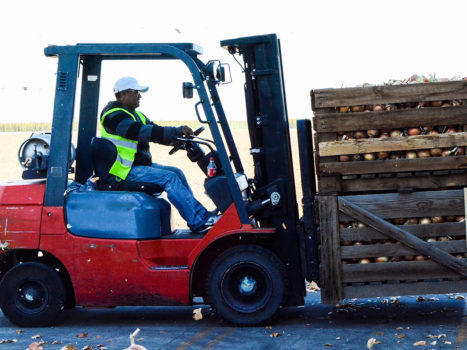Weighing in on freight logistics for September, Cain Adams at Trinity Logistics/Longboard Logistics in Boise, ID, filed this report:
“September was steady with contract orders but dead slow on open orders,” he said. “It was the most uneventful month we have seen in years.”

Cain continued, “We logged on Skype with customers, hearing about the 20-30 freight brokers calling customers each day. Produce brokers were more annoyed with those calls than other months. Our office knows best to just let things work themselves out rather than bang on doors asking for business which is not there right now.” He said, “We have been improving our indoor putting skills, clicking a lot of likes on Instagram and sending nerdy memes back and forth with customers. Everyone is just at a stalemate. We are not pushing customers up on pricing for most lanes.”
And, he said, “It seems trucks are getting better money on potato loads than onion loads, yet the potato market feels similar to the onion market. We work both along with hops and dry LTL freight. Surprisingly, a week after Hurricane Dorian hit, we lost $1,725 on contract loads out of potato country in Idaho. The rate shot up from Idaho Falls to the Dallas, Houston and Atlanta markets. We went from covering Houston a week prior at $3,300 to $4,400. It was crazy fast. Then, it went back down almost overnight. We covered a lot of potato loads into Florida but not as many onion loads. We thought there would be more.”
He added, “We pulled from a few onion markets. A new one, for us, was Ulysses, KS. This area proved well for flatbeds into the St Louis, Atlanta, Chicago, Dallas and Houston markets at great rates.
Treasure Valley loads were a mix of flats and reefers. The markets we found taking this product was Phoenix, Dallas, Houston and Chicago. We shipped to other markets, but these stood out for us.”
During late September he said, “Sheds in the area still have a lot to bring into storage. The last week of September is going to get cooler weather, which should really firm the onions up. We are excited to see this happening for our neighbors. Finally.”
Looking at Washington, Cain said, “Tri-Cities seemed to send flats to all parts of the Northeast, Chicago and Wisconsin for us. We did, however, send flats from the Walla Walla and Warden areas to Dallas at decent pricing. Houston was a bit harder to cover.”
In Nevada, “Yerington white onions on Conestoga and reefers were requested from the Chicago, Dallas and Houston markets. There were a ton of flatbed trucks available, but we do not like to put whites on these and passed. Quality, at landing, is more important for us and the customers. Pricing per bag, to Chicago, was actually equal for a reefer and a Conestoga because most had to dead head out of California. We were seeing $3.75 to $4 per 50, depending on the day, into Chicago.”
Next door, he said, “Utah is opening up. This pulls some trucks away from potato country in Idaho. That then pushes up the potato load pricing a little. California is pretty much dead for us other than out of Hollister. Trucks are super easy to get out of this area. If you can find good quality, the trucks will be easy to find.”
Looking ahead, Cain said, “October is always a month we watch close. Many shippers don’t even ship until October. This is when we put our putting green away and get down to business. Brokers want tight numbers so they can bid lanes yet don’t want to get killed if the markets get crazy. They have all seen transportation pricing run up overnight. Shippers want those onions looking firm and cured by Mother Nature along with cooler temps so they can fill sheds and have a natural AC unit for storage.”
He said, “Oct. 15th is our date. Chains get hung on trucks, snow starts to fly, and Wyoming can get tricky. I would recommend all customers who run flats to add a weather app to their cell. Drop in Billings, MT, Rawlins, WY, Farmington, NM and La Grande, OR. By doing this, they can see when the snow or freezing temps are coming in. Looking at the 10-day forecast can help them price a lane using the proper equipment. We don’t want a flatbed breaking down and freezing a load.”
And, he said, “Another thing we are seeing, which can hurt everyone, is freight brokers putting higher prices out on load boards. You see 10 different brokers competing for the same load, but what we are seeing is some are adding $300 to $500 more than what the customer wants to pay. This then pushes up all other loads. Be diligent on your pricing. Personally, if I see a broker getting out of line on a board, I call them asking if their load is covered. If so, to take that load down. Maybe that’s going to far but sometimes it helps get things back to where they should be.”
Cain concluded, “We cannot predict what this fall brings. It’s hard not to open a paper without seeing a brick and mortar store closing – or 400 of them. Dry freight is lagging, and we think it will keep lagging. I don’t use vans too often for freight, but if the weather is good, on certain lanes, this may be a good year to check into insulated vented vans.
“Those Southern lanes is what I would review. Instead of paying $2.25 a mile, a guy may get a truck at $2 a mile. Those quarters add up fast. It’s just a thought I was having while we finished up some putt-putt golf. Cheers and we hope everyone can move their amazing products to market. We know all of you care about what you do, and it shows.


